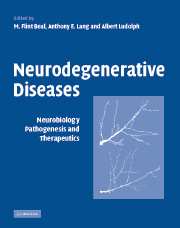Book contents
- Frontmatter
- Contents
- List of contributors
- Preface
- Part I Basic aspects of neurodegeneration
- Part II Neuroimaging in neurodegeneration
- Part III Therapeutic approaches in neurodegeneration
- Normal aging
- Part IV Alzheimer's disease
- Part VI Other Dementias
- Part VII Parkinson's and related movement disorders
- Part VIII Cerebellar degenerations
- Part IX Motor neuron diseases
- 50 An approach to the patient with motor neuron dysfunction
- 51 The genetics of amyotrophic lateral sclerosis
- 52 Current and potential therapeutics in motor neuron diseases
- 53 The hereditary spastic paraplegias
- 54 Spinal and bulbar muscular atrophy (Kennedy's disease): a sex-limited, polyglutamine repeat expansion disorder
- 55 Spinal muscular atrophies
- 56 Western Pacific ALS/parkinsonism–dementia complex
- Part X Other neurodegenerative diseases
- Index
- References
53 - The hereditary spastic paraplegias
from Part IX - Motor neuron diseases
Published online by Cambridge University Press: 04 August 2010
- Frontmatter
- Contents
- List of contributors
- Preface
- Part I Basic aspects of neurodegeneration
- Part II Neuroimaging in neurodegeneration
- Part III Therapeutic approaches in neurodegeneration
- Normal aging
- Part IV Alzheimer's disease
- Part VI Other Dementias
- Part VII Parkinson's and related movement disorders
- Part VIII Cerebellar degenerations
- Part IX Motor neuron diseases
- 50 An approach to the patient with motor neuron dysfunction
- 51 The genetics of amyotrophic lateral sclerosis
- 52 Current and potential therapeutics in motor neuron diseases
- 53 The hereditary spastic paraplegias
- 54 Spinal and bulbar muscular atrophy (Kennedy's disease): a sex-limited, polyglutamine repeat expansion disorder
- 55 Spinal muscular atrophies
- 56 Western Pacific ALS/parkinsonism–dementia complex
- Part X Other neurodegenerative diseases
- Index
- References
Summary
Introduction and classification
Inherited disorders in which the predominant clinical syndrome is gait disturbance due to lower extremity spastic weakness are referred to collectively as the hereditary spastic paraplegias (HSPs). The various types of HSP are classified clinically according to the mode of inheritance (dominant, recessive, and X-linked); and whether lower extremity spasticity and weakness and often urinary urgency and subtle dorsal column impairment occur alone (“uncomplicated HSP”), or are accompanied by additional neurologic or systemic symptoms for which alternative causes are excluded (“complicated HSP”) (Harding, 1983).
There are at least 20 genetically distinct types of HSP (Table 53.1) including ten dominant, seven recessive, and three X-linked HSP syndromes. Eight of these HSP syndromes are “uncomplicated;” eight of these are “complicated” by the presence of additional neurologic signs; and four of these may present as either “uncomplicated” or “complicated” HSP syndromes. For some of these latter syndromes, both “uncomplicated” and “complicated” HSP phenotypes may coexist even in the same family (Table 53.1).
It is important to recognize that the HSPs are classified clinically, rather than on the basis of subclinical involvement or neuropathologic findings. Certainly, lower extremity spastic weakness may be an important feature of many other disorders, both inherited and apparently sporadic including such diverse disorders as amyotrophic lateral sclerosis, Friedreich's ataxia (Berciano et al., 2002; Ragno et al., 1977), Machado Joseph disease (spinocerebellar ataxia type 3), Charlevoix–Sanguenay syndrome (Engert et al., 2000), primary lateral sclerosis, and familial Alzheimer's disease due to presenilin 1 mutation (Brooks et al., 2003; Assini et al., 2003; Tabira et al., 2002).
- Type
- Chapter
- Information
- Neurodegenerative DiseasesNeurobiology, Pathogenesis and Therapeutics, pp. 794 - 802Publisher: Cambridge University PressPrint publication year: 2005
References
- 2
- Cited by

